
As part of your professional development, you would regularly read about research and developments in healthcare. In Part C of OET Reading, there are two such texts that are written on topics of interest to a broad range of healthcare professionals.
This guide is all about OET Reading Part C: Learn about the format and the skills tested, see a sample question, learn some top tips and find out how to prepare for this part of the test.
Test Format:
The two Part C texts are around 800 words each. They are similar to journal or review articles and usually contain a range of opinions or perspectives on a certain topic. Some examples include texts about new developments in treatments or technologies, about the experience of a particular patient or health professional, or about research into the causes or cures of conditions.
Each Part C text has eight 4-option multiple-choice questions and these follow the order of the text.
OET Reading Part C at a glance:
- 2 texts
- 800 words each
- Articles or article extracts
- Eight 4-option multiple-choice questions per text
- 45 minutes for Parts B and C combined
Skills for Reading Part C:
OET Reading Part C tests your ability to understand explicit and implicit meaning – sometimes you need to recognize what the writer is implying. Other skills include your ability to identify main points or main ideas, detailed meaning, and to identify attitude or opinion, that is, how a writer or other people mentioned in the article feel or think about something. And there are also questions which require you to understand vocabulary in context, for instance, to recognise how a particular word or phrase is being used or what a reference word like ‘it’ ‘that’ or ‘they’ is referring to.
To complete the task successfully, you will need to identify the relationship between ideas at sentence and paragraph level.
Sample questions:
Here’s a Reading Part C from Sample Test 1. You can find the whole test and answer key in the Sample Reading Test section.
There are instructions at the start. For OET on paper, there’s a reminder to shade the circle A B C or D completely. On computer, you select the correct answer with a left click of your mouse just like in Part B.

OET on paper – Part C instructions.
If you’re taking the test on paper, your texts and questions are on separate pages.
Part C Texts:


Part C questions:
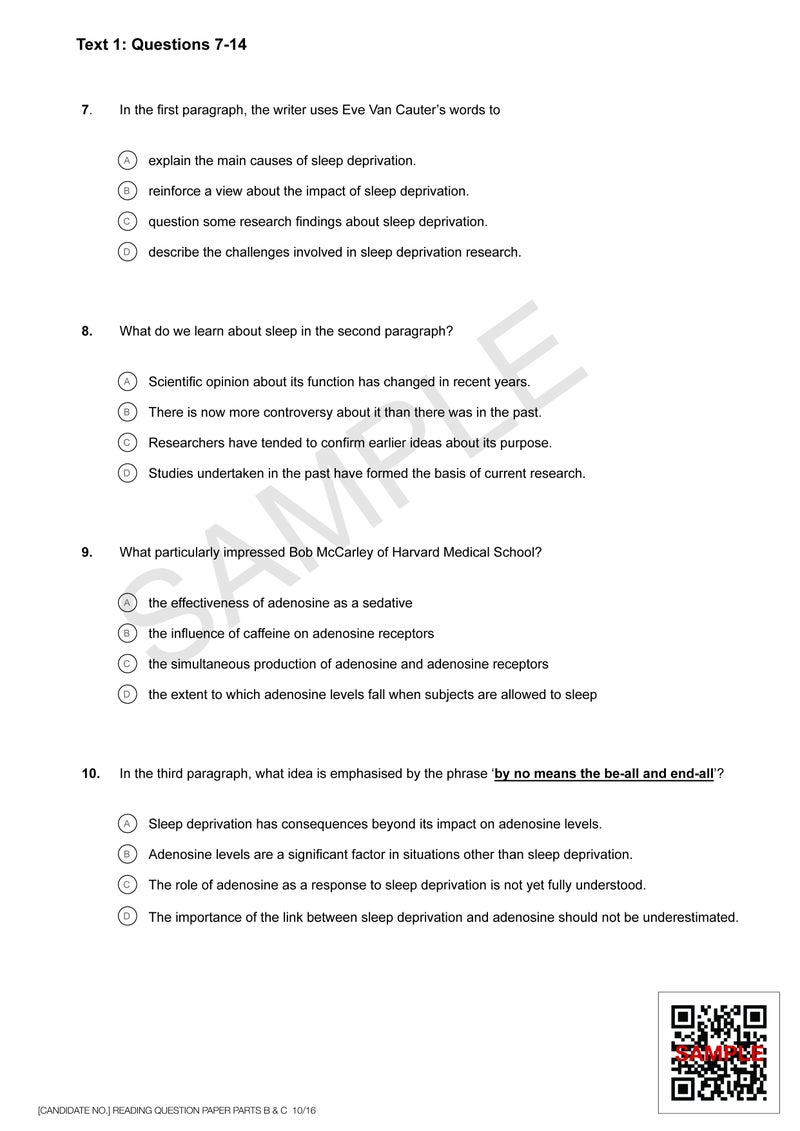

If you’re on computer, the screen is split with your text on the left and the questions on the right.
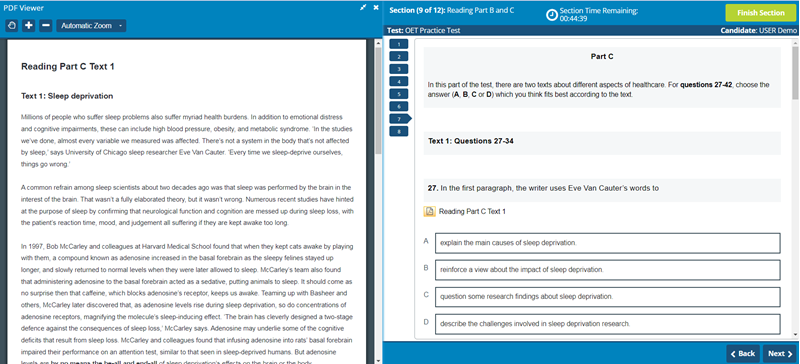
OET Reading Part C on computer
The questions follow the order of the text and will often tell you where to look. For instance, question 7 below directs you to the first paragraph, the next question to the second paragraph. So, once you’ve answered a question, keep moving through the text; there is no need to return to that section again.

Lexical and reference type questions will also be clearly marked in the text. You will see which paragraph the phrase is in and it will be bolded and underlined. See the example question and the relevant paragraph from the text below.

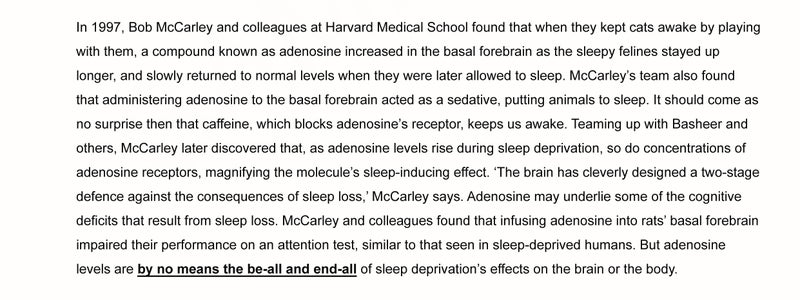
Remember that there are 2 texts with 8 questions each, so you need to manage your time and not spend too long on a single question.
Test tips:
Here are 4 tips to succeed in Part C.
1) Read with purpose.
Don’t read the whole text first. Instead, start with the first question and read only to find the answer to it. Before you even look at the options (A-D), you should try to answer the question in your mind.
2) Read all answer options carefully.
Answer options may share some features. Look at this example:
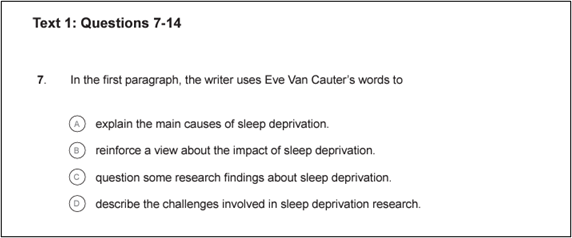
All of the answer options (A-D) in Question 7 mention ‘sleep deprivation’, which is the topic of the text. If you are going too quickly, it’s easy to choose an answer option simply because you see words that you saw in the text. However, simply matching vocabulary is not the point of this test. You need to understand how the options are different from each other in order to choose the right one.
3) Don’t rush.
Skimming and scanning will not help you in Part C. The questions clearly direct you to the relevant place in the text and come in order, so you don’t need spend time searching. Your time instead should be spent on reading carefully in order to understand.
Look at this example:
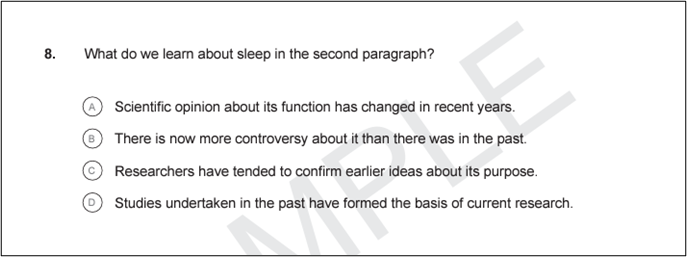
To answer this question, you need to read that whole second paragraph slowly enough to be able to understand. When you read the answer options, you might need to return to confirm your choice, but you should already have a good idea of what the answer will be based on your first read.
4) Manage your time.
You need to read slowly enough to understand, but you also need to watch the clock so that you don’t spend too long on one question. Just like in other parts of the test, time management is critical. If you’re spending more than a couple of minutes on a question, have a guess and return to it if you have time.
Preparation recommendations:
As you prepare for Reading Part C, you will be improving your ability to read the types of longer texts that you will encounter as part of your ongoing professional development.
Here are some suggestions to work on your reading skills for Part C.
1) Build your stamina.
OET Reading takes an hour, so by the time you get to Part C, you might be getting tired. The Part C texts are around 800 words each, and the questions require you to read carefully. So, before test day, make sure you’re used to reading long texts and reading for long periods of time. If this is new for you, start with small chunks of time, a few minutes, and build up your ability to read, without distractions, for longer and longer periods.
2) Build vocabulary.
There is a direct correlation between the amount of vocabulary you know and your ability to comprehend text. Your vocabulary knowledge also impacts the speed at which you read. If you automatically recognise words and phrases or chunks of text, you will read faster than if you need to think about each word’s meaning individually. So, learning new words should be a key part of your OET preparation.
3) Read with enthusiasm.
Sometimes, you might find a topic uninteresting, or you might dislike reading itself. In her book, ‘Teaching Reading skills in a foreign language’, Christine Nuttall wrote: 'speed, enjoyment, and comprehension are closely linked with one another'. In other words, how much you understand a text is related to how quickly you’re reading and how much you’re enjoying it. So, when it comes to preparing for OET Reading, adopt a positive attitude, even if you need to fake it. Choose texts to read and tell yourself, 'I’m excited to find out what this text will tell me. I’m going to learn something new and I can’t wait!’ Read actively, and add emphasis and feeling to the words as you read them, even just in your mind. Simply running your eye across a text will not be enough to help you answer Part C questions.
4) Read more!
If you wanted to improve your swimming ability, simply thinking about swimming or watching videos about it will not help you when you get into the water. Similarly, if you want to improve your reading comprehension, speed and even your enjoyment, you need to read. Check out the links below for suggested websites and publications to practise with.
Recommended reading:
Reading Part C can be challenging, so investing time now in building up your stamina, vocabulary and test taking strategies will benefit you on test day.
Keep building your OET Reading skills with these resources:
Reading Part C on-demand lesson library (YouTube)
